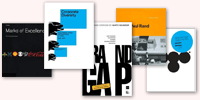
Opinion BY Armin
Saab’s Griffin Caught Between a Rock and a Hard Place
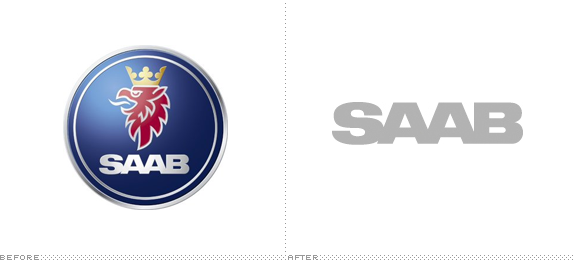
Established publicly in 1949 with the launch of its first model, the Saab 92, Saab Automobile AB is a Swedish car manufacturer with a strong history of safe, sturdy, well-performing cars — unfortunately the same can’t be said for the stability and continuity of those cars’ parent company. Read on for the soap opera-ish story.
Continue reading this entry

DATE: Jan.15.2013 POSTED BY: Armin
POSTED BY: Armin CATEGORY: Automobile
CATEGORY: Automobile  COMMENTS:
COMMENTS:

TAGS: Sans Serif, stockholm design lab, uppercase,

A B-Side BY Armin
SEAT
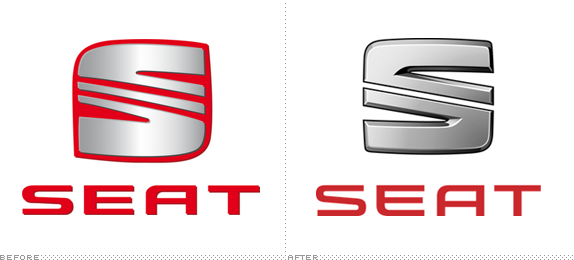
About: (Est. 1950) “A member of the Volkswagen Group, SEAT has its headquarters in Martorell (Barcelona), exporting approximately 75% of its production to 72 countries. SEAT is market leader in Spain, and in 2010 reached a turnover amounting to 4.7 billion euros, with total sales of 339,500 vehicles.SEAT Group employs 13,000 professionals at its three production centres in Barcelona — Zona Franca, El Prat de Llobregat and Martorell, where it manufactures the highly successful Ibiza and Leon, amongst other models.”
Design by: N/A
Ed.’s Notes: It’s not the funnest game of spot the differences, but there are some between the old and new.
Relevant links: Press Release (extensive!). More images and a timeline of the logos.
Thanks to Pierre des Courtis for the tip.

DATE: Oct.04.2012 POSTED BY: Armin
POSTED BY: Armin CATEGORY: Automobile The B-Side
CATEGORY: Automobile The B-Side  COMMENTS:
COMMENTS:

TAGS: bevel, chrome, gradient, Sans Serif,

Opinion BY Armin
Impala Hits the Gym
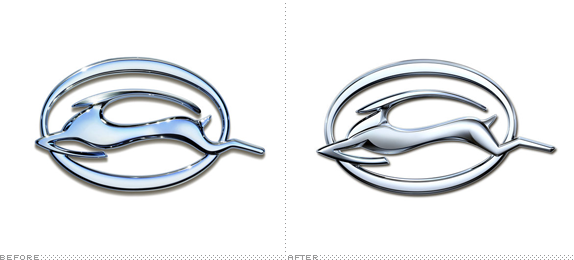
First produced in 1958, the Impala is one of the most popular — and unpopular — brands from Chevrolet. Once one of the great-selling cars in the 1960s and ’80s its design in the ’90s and early ’00s has left much to be desired for, having gone from elegant and muscular to a flat, long, and depressed look to a generic, rental-looking car. Popular with police departments though. At the New York auto show this week, Chevrolet introduced the much nicer 2014 Impala and revised its badge, which has shown a stylized impala (an African antelope) since the ’60s. The newest version was designed by Joann Kallio, who, as master car writer Phil Patton reports, “has been a graphic designer at G.M. for more than 25 years and is the lead creative designer on Chevrolet global badging.” Global badging, now there is a department I didn’t know existed.
Continue reading this entry

DATE: Apr.10.2012 POSTED BY: Armin
POSTED BY: Armin CATEGORY: Automobile
CATEGORY: Automobile  COMMENTS:
COMMENTS:

TAGS: badge, car, metallic finish,

Opinion BY Armin
A Datsun Logo Datsucks

First sold in 1931 by DAT Motorcar and purchased by Nissan in 1933, Datsun is a brand of cars that was discontinued in 1981 in both Asian and American markets. With some quirky models in its history, Datsun has sort of a cult, hipsterish following. This week Nissan announced that it would be reviving the brand in India, Indonesia, and Russia starting in 2014 and it will be “a green car, affordable car, small displacement, high local content.” After 21 years off the market, it needed a new logo.
Continue reading this entry

DATE: Mar.23.2012 POSTED BY: Armin
POSTED BY: Armin CATEGORY: Automobile
CATEGORY: Automobile  COMMENTS:
COMMENTS:


Opinion BY Armin
Jaguar Leaps Forward this Leap Year
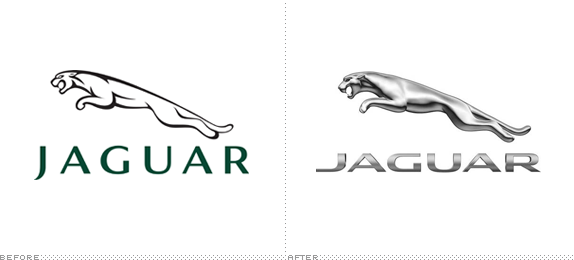
Established in 1922, Jaguar is a British luxury car manufacturer that makes real pretty and expensive cars. Jaguar is part of Jaguar Land Rover, which in turn is owned by Tata Motors. This week, Jaguar introduced a new marketing campaign created by Spark44 — a communications agency owned in part by Jaguar Land Rover — that “is driven by the belief that Jaguar makes the world’s most instinctively rewarding performance cars,” and aims “to increase awareness of the brand amongst a new audience in line with the brand’s ambitious future plans.” With it came a revised logo and corporate typeface.
Continue reading this entry

DATE: Feb.29.2012 POSTED BY: Armin
POSTED BY: Armin CATEGORY: Automobile
CATEGORY: Automobile  COMMENTS:
COMMENTS:

TAGS: car, extended, Sans Serif,

A B-Side BY Armin
Monza
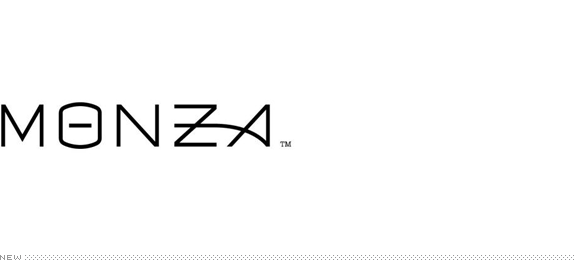
Monza is a luxury car detailing and protection center in Dubai, taking in only expensive cars none of us can afford. The name comes from the race circuit and city in Italy. See the full project by Prague-based Higher to see how the race track element plays into the logo and for an extended range of applications.

DATE: Sep.23.2011 POSTED BY: Armin
POSTED BY: Armin CATEGORY: Automobile The B-Side
CATEGORY: Automobile The B-Side  COMMENTS:
COMMENTS:

TAGS: dubai, sans serif,

A B-Side BY Armin
Bridgestone
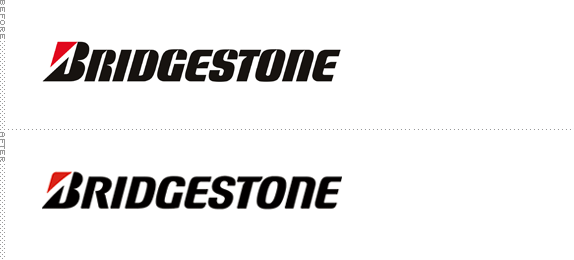
Established in 1931 and based in Japan, Bridgestone manufactures tires for motorcycles, and passenger and commercial vehicles, among other tire and tube products. Earlier this month, Bridgestone announced a revision to its corporate philosophy as well as the Bridgestone Logo, Bridgestone Mark and B Mark. The press release explains: “This refinement is intended to reflect a sense of ‘coexistence with people around the world’, ‘flexible strength’ and ‘a sense of speedin adjusting to change’. This is an evolution from the previous logo which expresses ‘strength’ and ‘a sense of physical speed.’”
Thanks to Roy Levitt for first tip.

DATE: Mar.28.2011 POSTED BY: Armin
POSTED BY: Armin CATEGORY: Automobile The B-Side
CATEGORY: Automobile The B-Side  COMMENTS:
COMMENTS:

TAGS: bridgestone, italic, sans serif,

Opinion BY Armin
Chrysler’s Sucker Punch
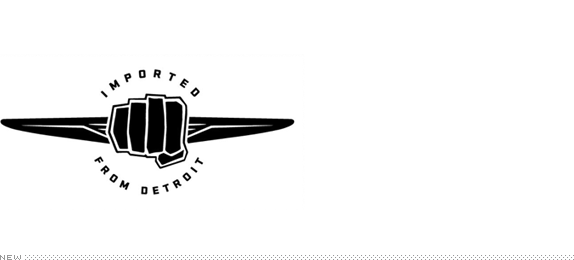
Trying to rebound from bankruptcy and the beating it has taken from non-American car brands, Chrysler, now owned in part by Fiat, is attempting to bring back some attitude to the industry as well as some much needed love to the city of Detroit. During this year’s Superbowl XLV, Chrysler ran a two-minute commercial featuring lovely shots of the city while local boy wonder, Eminem, drove a Chrysler 200 to the riff of his hit “Lose Yourself” culminating in him pointing at your face and stating “This is the Motor City; this is what we do.” The ad served to introduce the tagline, “Imported from Detroit,” which now has its own logo. Both the commercial and logo were created by Wieden + Kennedy. Chrysler has just launched a collection of “Imported from Detroit” merchandise, and part of the profits go to four different charities: Boys and Girls Club of Southeastern Michigan, Habitat for Humanity Detroit, Marshall Mathers Foundation, and Think Detroit PAL.
Continue reading this entry

DATE: Mar.28.2011 POSTED BY: Armin
POSTED BY: Armin CATEGORY: Automobile
CATEGORY: Automobile  COMMENTS:
COMMENTS:

TAGS: chrysler, sans serif, wieden and kennedy,

Opinion BY Armin
Dodge Loses its Horns
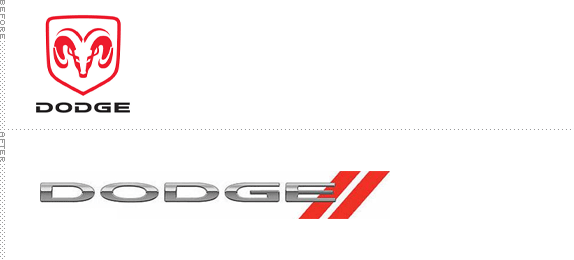
In November of last year, Fiat — which owns the majority of what was once Chrysler Group LLC, which itself owned Dodge — announced that it would be separating its line-up into two separate brands: One for the popular Dodge Ram trucks and the other for the normal-sized cars. The first brand is now simply known as Ram and has kept the original ram logo, leaving the second brand, Dodge, to look for a logo of its own.
Continue reading this entry

DATE: May.26.2010 POSTED BY: Armin
POSTED BY: Armin CATEGORY: Automobile
CATEGORY: Automobile  COMMENTS:
COMMENTS:

TAGS: dodge, metallic finish, sans serif,

Opinion BY Armin
The Cat got Peugeot’s Tongue

It’s not everyday that we begin the critique of an identity prefaced by the accumulated equity of 200 years but… Peugeot was first established in the Montbeliard region in eastern France in 1810 by brothers Jean-Pierre and Jean-Frédérice as a steel foundry manufacturing a bevy of industrial products, from simple saw blades to coffee grinders. In 1885 another Peugeot family member first dabbled in wheeled locomotion by producing a bicycle, and four years later they introduced a steam-powered tricycle and by 1910, Peugeot was fully committed to the burgeoning automobile industry (see video at the end of post for this vast range of products). The rest, well, is history, as Peugeot has become one of the most well known and respected names in the automobile industry (and few names roll off the tongue as fancifully). Last week, among other news like concept cars and stuff, Peugeot unveiled an evolution of its lion identity — designed by Paris-based BETC Design — along with a new tag line, “Motion & Emotion”.
Continue reading this entry

DATE: Jan.11.2010 POSTED BY: Armin
POSTED BY: Armin CATEGORY: Automobile
CATEGORY: Automobile  COMMENTS:
COMMENTS:

TAGS:






























